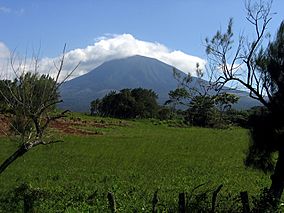Guanacaste National Park (Costa Rica) facts for kids
Quick facts for kids Guanacaste National Park |
|
|---|---|
|
IUCN Category II (National Park)
|
|

Rincón de la Vieja Volcano, in the park
|
|
| Location | Costa Rica |
| Area | 340 km2 (84,000 acres) |
| Established | 9 July 1991 |
| Governing body | National System of Conservation Areas (SINAC) |
| Lua error in Module:Location_map at line 420: attempt to index field 'wikibase' (a nil value). | |
Guanacaste National Park (in Spanish: Parque Nacional Guanacaste) is a special place in northern Costa Rica. It is a National Park that helps protect a huge area of nature. This park is part of a bigger area called the Area de Conservación Guanacaste World Heritage Site.
The park stretches from the slopes of the Orosí and Cacao volcanoes. It goes all the way west to the Interamerican Highway. Here, it connects with the Santa Rosa National Park. The park was created in 1989. A scientist named Dr. Daniel Janzen worked hard to make it happen. He helped raise money and campaigned for the park. His goal was to create a safe path for animals. This path connects dry forests with rainforests. Many animals travel between these areas during different seasons.
Guanacaste National Park covers about 340 square kilometers. It is home to an amazing variety of life. Scientists have found 140 types of mammals here. There are also over 300 kinds of birds. You can find 100 different amphibians and reptiles. Plus, over 10,000 types of insects live in the park! Because so many different species live here, the Costa Rican government decided to protect this land. The park links the nearby Santa Rosa National Park with the high forests of the Orosi and Cacao volcanoes. It also connects to the rainforests on the Caribbean side of the country.
Contents
Exploring Guanacaste National Park
The Tempisque River flows through the lower parts of the park. You can find dry forests in the lower areas. Higher up, there are cloud forests, which are often misty and cool.
Hiking Trails and Ancient Art
There are several trails that wind through the park. These trails are great for hiking and exploring nature. One special trail leads to the Orosi Volcano. Near a flat area called El Pedregal, you can see something very old. There are petroglyphs, which are ancient drawings carved into rocks. These carvings were made by people who lived here long ago.
Park Facilities and Nearby Towns
The closest city to the park is La Cruz. It is located to the northwest. Guanacaste National Park has several important buildings. It is home to the main office of the Guanacaste Conservation Area. There are also stations for park rangers and researchers. These include Pitilla in the northeast, Cacao on the side of the Cacao volcano, and Maritza. Maritza station is located near both volcanoes. These stations help manage the park and support its visitors and scientists.
Park History
Guanacaste National Park was officially created in 1989. It became part of the larger Guanacaste Conservation Area. This area also included the Santa Rosa National Park and Rincón de la Vieja National Park. In 1994, all these parks became part of the National System of Conservation Units (SINAC). Later, in 1999, the entire area was named a World Heritage Site. This means it is a place of special importance to everyone in the world. In 1995, the Junquillal Bay Wildlife Refuge was also added to this protected group of sites.
A Unique Experiment: Orange Waste
In 1989, something unusual happened in the park. About 12,000 tonnes of orange waste was put on some bare soil. This was done with an agreement from the park authorities. Fifteen years later, this area had completely changed. It had grown into a rich variety of plants. This showed how nature can recover and thrive, even with a little help.
See also
- Guanacaste Conservation Area
- Area de Conservación Guanacaste World Heritage Site
 In Spanish: Parque nacional Guanacaste para niños
In Spanish: Parque nacional Guanacaste para niños

